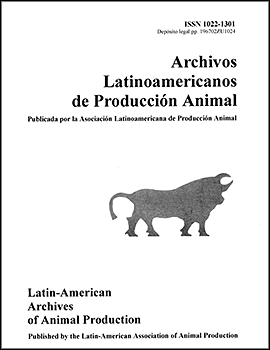
|
Archivos Latinoamericanos de Produccion Animal
Asociacion Latinoamericana de Produccion Animal
ISSN: 1022-1301
EISSN: 1022-1301
Vol. 12, No. 4s1, 2004, pp. 54-58
|
 Bioline Code: la04028
Bioline Code: la04028
Full paper language: Spanish
Document type: Research Article
Document available free of charge
|
|
|
Archivos Latinoamericanos de Produccion Animal, Vol. 12, No. 4s1, 2004, pp. 54-58
| es |
Caracterización, Evaluación y Conservación de Caprinos Moxotó en el Estado de Pernambuco, Brasil
M. N. Ribeiro, J. C. V. Oliveira, L. L. Rocha, A. G. C. Alves, F. F. R. Carvalho, y J. R. B. Sereno
Resumen
Este trabajo tuvo como objetivo caracterizar y evaluar el estado de conservación de la raza Moxotó en el Estado de Pernambuco, región nordeste de Brasil. La caracterización fue basada en aspectos fenotípicos de los animales, censos poblacionales y entrevistas a productores para describir el sistema de producción de estos animales naturalizados en esta región. Las medias y desviaciones típicas de las medidas morfométricas: longitud corporal (CC), altura a la cruz (AC), perímetro toràcico (PT) y peso adulto (PA) de hembras de la raza Moxotó en los rebaños estudiados fue, respectivamente 77,30 ± 9,88 cm; 60,43 ± 7,31 cm; 63,13 ± 7,02 cm y 30,13 ± 8,43 kg. Del total de animales, aproximadamente 76% son del tipo Sin Patrón Racial Definido (SPRD), producto de cruzamientos con animales nativos, principalmente Moxotó y Nambi con razas exóticas como Bhuj, Saanen, Boer y Anglonubiana, con predominancia de las dos últimas. Sólo 12% de los animales son de razas naturalizadas, con predominancia de la Moxotó. Los criadores màs antiguos en la actividad afirmaron que el número de animales de esta raza ha disminuido progresivamente en los últimos años, evidenciando que cerca de 76 % del rebaño de la región actualmente es mestizo, debido a cruzamientos con razas exóticas.
Palabras-clave
Caprino, Recursos genéticos, Caracterización, Sistemas extensivos
|
| |
| en |
Characterization, evaluation and conservation of the Moxotó goat breed in Pernambuco, Brazil
M. N. Ribeiro, J. C. V. Oliveira, L. L. Rocha, A. G. C. Alves, F. F. R. Carvalho, y J. R. B. Sereno
Abstract
This work aimed to characterise and evaluate the state of conservation of the goat breed in PernambucoState, in the Northeast region of Brazil. The methodology used is based on phenotypic aspects, populational census and interviews with farmers so as to characterise the production system of these animals in this region. The means and standard deviations for morphometric measures included: body length (BL), hip height (HH), chest perimeter (CP) and adult body weight (AW) of females of the breed. These were respectively 77.30 ± 9.88 cm; 60.43 ±7.31 cm; 63.13 ±7.02 cm and 30.13 ±8.43 kg. Of all animals studied, approximately 76% are Without Breed Pattern Defined (WBPD), product of crossbreeding with native animals, especially Moxotó and Nambi with exotic breeds such as Bhuj, Saanen, Boer and Anglo-Nubian, with a predominance of the latter. Only 12% are native breeds, with predominance of Moxotó. Some older farmers confirm that the numbers of animals of this breed are decreasing progressively in the last few years. This is confirmed where at present 76% of the herd in the region are of mixed breed, due to crossbreeding with exotic breeds.
Keywords
Goat, Genetic resources, Characterization, Range management
|
| |
© Copyright 2004 - ALPA. Arch. Latinoam. Prod. Anim.
Alternative site location: http://www.alpa.org.ve/ojs/index.php
|
|
